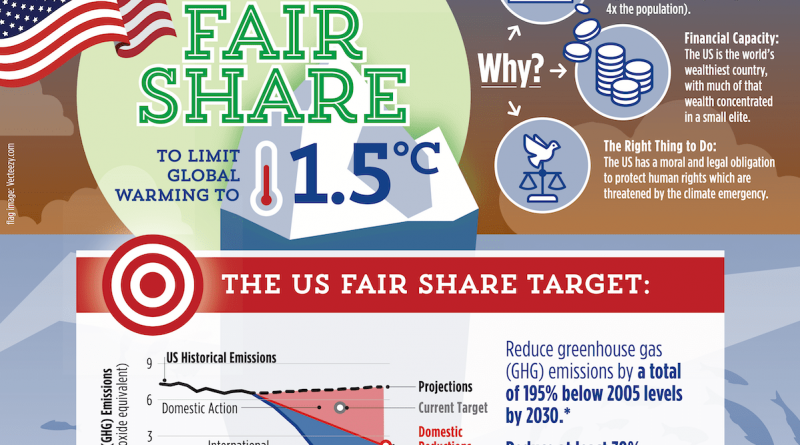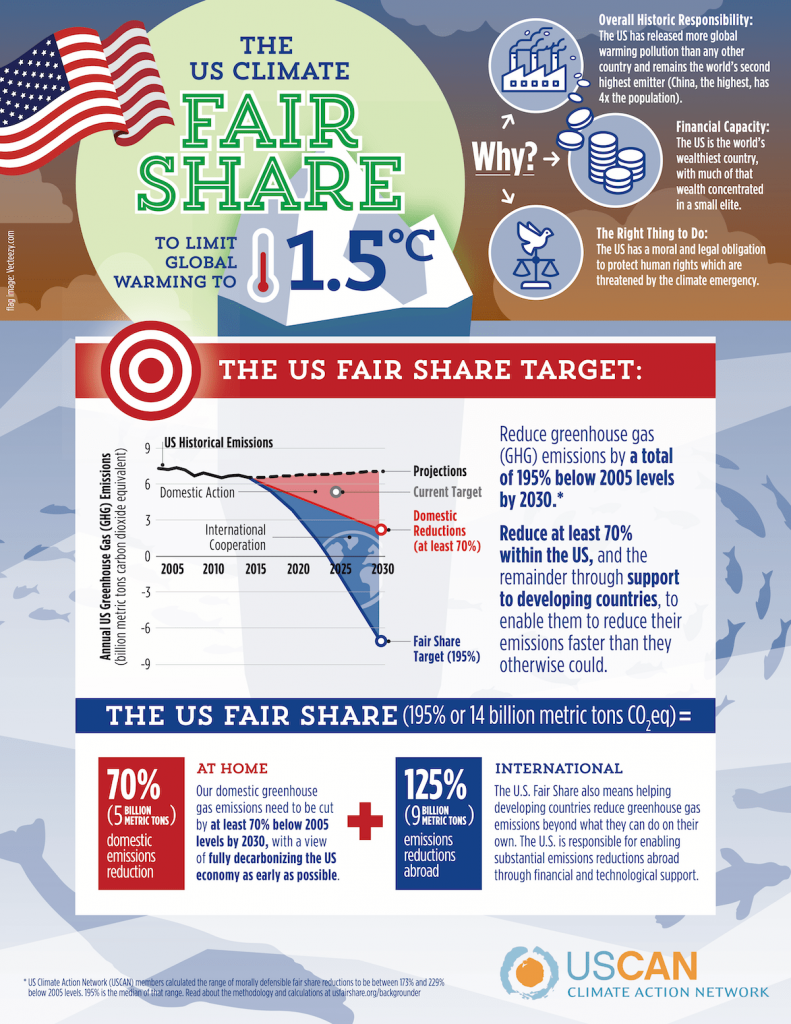Opinion: We’re Aiming For The Wrong Climate Targets. Let’s Talk About Improving Our Aim

Photo: USA Fair Share

Let’s forget about national boundaries and governments for a minute and face the fact that the whole world needs to reduce its collective greenhouse gas emissions. We — meaning all of humanity — need to emit close to 50 percent less by 2030 (and get to net-zero emissions by 2050). So far global emissions are still rising, so we need to make a dramatic turn in the next few years if we are to avoid the most catastrophic effects of climate change. It’s a global problem — greenhouse gases emitted anywhere cause problems everywhere.
Responsibility
How are we going to pull this off? Some would argue that each nation should reduce its emissions by roughly 50 percent. Despite the apparent even-handedness of that approach, it would be incredibly unfair and inequitable. Some nations have emitted far more greenhouse gases than others and played a much larger role in creating the climate problem. Some nations have emitted very little and have almost no responsibility for it. It seems reasonable that those who have done the most to cause the problem should do the most to solve it. In other words, each nation has a level of responsibility, based on its cumulative greenhouse gas emissions. (Cumulative emissions count because CO2 stays in the atmosphere for 300 – 1,000 years.)
Capacity
The transition to powering each economy with solar, wind, and other renewables will cost money. Some nations have vastly greater wealth than others. Given that this is a shared problem that we need to solve together, it’s neither realistic nor fair to expect poorer nations to put up as much money as wealthy ones. In other words, each nation has a different level of capacity to pay, based on its level of wealth.
Furthermore, countries that are rich, have, almost without exception, gotten rich through powering their economies by burning fossil fuels. The correlation is remarkable. To a considerable extent responsibility and capacity go hand in hand.
The first way a nation can do its fair share is by rapidly reducing its own emissions. However, we need to get the whole world’s emissions down significantly in the next 9 years. We will only succeed if nations that have historically been big climate polluters, in order to meet their fair share of responsibility, not only lower their own emissions, but also help finance the global effort outside their borders as well.
Online Calculator
If each nation is going to contribute its fair share in the shared global effort to stabilize the climate system, it would be helpful to know what each nation’s fair share is. This has been a matter of considerable debate in international climate negotiations. So far no consensus exists, and we’ve hardly even begun to talk about this in the United States. Tom Athanasiou and his colleagues at EcoEquity and the Climate Equity Reference Project have been working on ways to calculate fair shares for each country. They have developed an extensive database, a rigorous methodology, and a new online calculator that allows for varying the weight given to different factors. They have a deep commitment to equity and have developed ways to calculate each nation’s share that only count the incomes of people above various global poverty levels. The results are fascinating.
What’s The U.S. Fair Share Target?
What’s the U.S. fair share target if we are to limit global warming to 1.5°C? A new report from the U.S. Climate Action Network (USCAN), drawing on the work by Athanasiou and his colleagues, offers an answer. USCAN is made up of a range of organizations from local grassroots groups to international NGOs and is focused on global climate change and global inequality. Their “U.S. Fair Share Target” takes into account the fact that cumulatively the U.S has emitted more greenhouse gasses than any other nation and is the wealthiest nation in the world, “with much of that wealth concentrated in a small elite.” (The U.S. is still the second largest emitter after China, which has four times the number of people. The U.S. also has one of the highest per capita emission rates among large nations.)
Not surprisingly, for the U.S, given our historical responsibility and capacity, our fair share is greater than our current total emissions. According to USCAN, our fair share of the global mitigation effort by 2030, is equivalent to reducing emissions 195 percent below our 2005 emissions level. They estimate that even with an all-out effort, the most we can reduce our domestic emissions by 2030 is probably 70 percent. That leaves the equivalent of a 125 percent reduction to be accomplished “through support to developing countries, to enable them to reduce their emissions faster than they otherwise could.”
How Can It Be?
How can it be our responsibility to reduce the emissions of some other nation? Partly it’s because we used up more than our share of the atmosphere’s capacity to absorb emissions. Other nations now need to limit their emissions because our past emissions are a major cause of the climate emergency. Furthermore, we got rich powering our economy by burning fossil fuels. The least we could do now is to spend some of our riches to ameliorate the problem we created. In a sense this is a legitimate cost of the way we built our wealth over the last 170 years. We didn’t pay that cost as we went. The bill has now come due, and it’s time for us to pay.
Interestingly, the climate proposal that Bernie Sanders ran on in the Presidential primary this year called for an equivalent of 161 percent reduction in U.S. emissions by 2030 — 71 percent domestically and the rest through paying $200 billion to the UN Green Climate Fund for poor nations’ green energy development.
Where Will The Money Come From?
Part of what makes it difficult for us in the U.S. to seriously consider meeting this kind of international responsibility is that we are constantly told that we can’t afford to do the things necessary for social justice and bold climate action. Consider this: since the pandemic started, while millions of people have suffered, the wealth of billionaires in the U.S. has increased by a trillion dollars! Do we really need to let that money sit in their accounts while the whole world approaches climate Armageddon? There’s plenty of wealth in the U.S., it’s just that we’ve allowed a very small elite to hoard a vastly disproportionate share of it.
Action
As USCAN says, “The American people must begin a profound new conversation about global climate justice and about the U.S.’s fair share in the shared global effort of stabilizing the climate system.” I urge you to explore their excellent graphic at USFairShare.org., to start conversations about this with many people and groups, and to share their graphic and this post widely. The year 2030 is not far off, and it’s time we started aiming for a responsible target.
***
Below is the full USCAN graphic, but I encourage you to go to their site to see the interactive explanations and more.

Russ Vernon-Jones was the Principal of Fort River Elementary School from 1990-2008. He is a co-facilitator of the Coming Together Anti-Racism Project in the Amherst area. He chairs the Racism, White Supremacy, and Climate Justice working group of Climate Action Now of Western Mass, and blogs regularly on climate justice at www.RussVernonJones.org.
